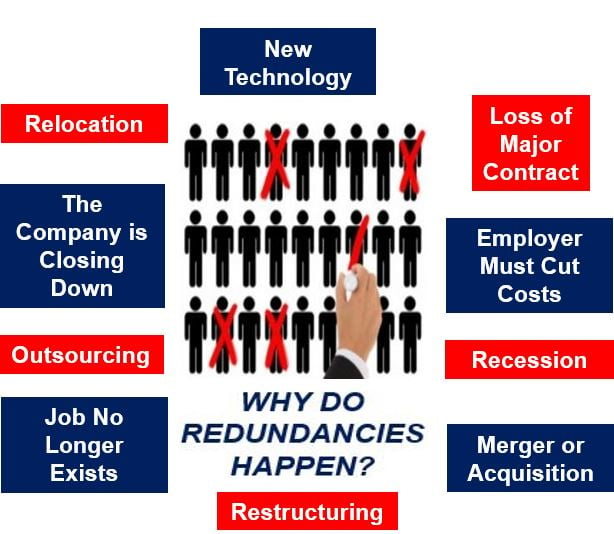Redundancy Pay If Company Goes Bust: Comprehending Your Entitlements in the UK
Redundancy Pay If Company Goes Bust: Comprehending Your Entitlements in the UK
Blog Article
Checking Out the Interplay Between Business Redundancy and Organizational Flexibility for Future Development
In the dynamic landscape of today's business world, the intricate partnership in between company redundancy and organizational versatility emerges as a crucial element for continual growth and success. Companies commonly encounter the obstacle of striking a fragile balance between preserving a level of redundancy to alleviate dangers and cultivating flexibility to react promptly to the ever-evolving market needs.
Importance of Firm Redundancy
Firm redundancy is a crucial component that enhances business resilience and reduces functional threats. By including redundancy actions within the business structure, business can better endure unanticipated disturbances and fluctuations in business environment. Redundancy works as a critical barrier, enabling companies to adapt and react successfully to unforeseen difficulties without compromising essential procedures.
One trick element of the significance of company redundancy is its function in guaranteeing continuity throughout times of dilemma. When faced with abrupt modifications or emergencies, redundant systems, sources, or personnel can action in to keep important functions and protect against prevalent interruptions. This continuity not just safeguards the company's reputation and consumer trust fund but additionally reduces economic losses and functional downtime.

Approaches for Business Flexibility

An additional important approach is spending in technology and infrastructure that can support versatility and scalability. Carrying out electronic devices, automation, and information analytics can simplify procedures, boost performance, and provide valuable insights for informed decision-making. Furthermore, creating adaptable organizational structures that permit quick modifications to market dynamics and client needs is vital for staying competitive in a rapidly evolving setting. By proactively recognizing possible disturbances and possibilities, organizations can proactively grow and adjust in an ever-changing service landscape.
Balancing Redundancy and Adaptability
Attaining a harmonious balance in between functional redundancy and organizational versatility is extremely important in navigating the intricacies of a dynamic company environment. Striking the appropriate equilibrium in between redundancy and adaptability is a delicate procedure that requires a deep understanding of the organization's objectives, industry dynamics, and danger tolerance.
To accomplish this balance, business require click site to carry out routine evaluations of their procedures to determine locations where redundancy is needed for danger reduction and where flexibility can drive technology and growth. Implementing flexible structures, cultivating a society of continual discovering and enhancement, and motivating open communication throughout all degrees of the company are crucial methods to balance redundancy and adaptability effectively. By aligning these 2 essential aspects, business can position themselves for sustainable growth and success in an ever-changing business landscape.
Instance Researches on Adaptation Success
In taking a look at instances of successful business adaptation, it becomes noticeable that the interplay between operational redundancy and flexibility is a specifying consider forming durable companies. One compelling study is that of Netflix. Initially a DVD rental solution, Netflix demonstrated impressive versatility by transitioning into a streaming system when digitalization disrupted the sector. By tactically buying innovation and web content development, Netflix not just thrived however survived in a swiftly developing market. An additional standout instance is Amazon. Starting as an online bookstore, Amazon continually adapted its organization design, expanding right into varied markets such as cloud computer and artificial knowledge. This flexibility allowed Amazon to remain ahead of competitors and satisfy changing consumer demands. Last but not least, Adobe offers a notable illustration of successful adjustment. The company moved from marketing software program licenses to a subscription-based model, making sure recurring income streams and improved consumer engagement. These case research studies emphasize the relevance of functional redundancy combined with organizational versatility visit site in fostering lasting development and competition.
Building Durability for Future Growth
Structure durability for future growth requires a tactical placement of functional processes with market characteristics and arising fads. Companies have to adapt to transforming environments by cultivating a culture of versatility, advancement, and continuous improvement. Resilience involves not just bouncing back from troubles however likewise proactively planning for future obstacles. One essential element of structure strength is spending in durable threat administration approaches to minimize prospective interruptions. This consists of situation preparation, branching out supply chains, and developing contingency prepare for various contingencies (who pays redundancy money).
In addition, cultivating solid relationships with stakeholders, such as clients, staff members, suppliers, and the area, is important for weathering unpredictabilities and preserving trust fund and assistance throughout stormy times. Reliable communication and openness play an important duty in structure durability, as they help align assumptions and promote partnership in browsing unpredictabilities.
In addition, companies need to prioritize understanding and development initiatives to upskill staff members and outfit them with the essential devices to adapt to altering circumstances. By spending in their workforce, business can boost their adaptability and agility, ultimately enhancing their durability for lasting future development.
Final Thought

In the dynamic landscape of today's organization world, the detailed connection in between company redundancy and organizational adaptability emerges as an essential aspect for continual growth and success. Business frequently read face the obstacle of striking a fragile balance in between maintaining a degree of redundancy to minimize risks and promoting flexibility to respond quickly to the ever-evolving market needs.To achieve this balance, business need to carry out regular analyses of their operations to identify areas where redundancy is necessary for threat mitigation and where versatility can drive innovation and growth.In conclusion, the interplay between company redundancy and organizational flexibility is important for future development. Structure resilience via a combination of redundancy and flexibility will certainly ensure that firms are prepared for the difficulties of the future.
Report this page